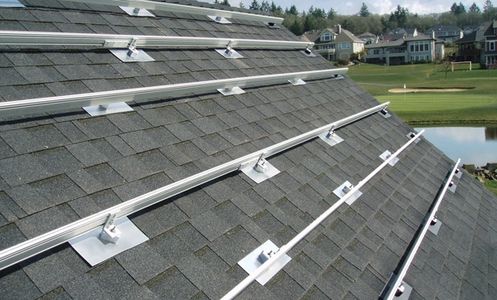Different Types of Solar Mounting Systems for Roofs in DC
One of the largest areas of innovation within solar involves the mounting system. Probably the most competitive solar product market, mounting systems are an important element of solar arrays—they secure solar panels to the roof. Here, we go over the basic categories of roof-mounted solar systems to help new installers or residents get a grasp on installation.
Sloped Roof Mounting Systems

Flashed Railed Systems - Shingled Roofs
The standard residential system uses rails attached to the roof to support rows of solar panels. Each panel, usually positioned vertically/portrait-style, attaches to two rails with clamps. The rails secure to the roof by a type of bolt or screw, with flashing installed around/over the hole for a watertight seal.

Clamps for Standing Seam Metal Roofs
Using clamps for standing seam metal roofs is a cost-optimized PV Mounting System for both residential and commercial metal roof mount installations. The type of system was designed to allow the attachment of PV modules or PV mounting rails directly to a commercial grade standing seam metal roof without penetrating the metal or collapsing the ridge in the metal roof material. The design is simple and low cost, but very effective. The clamp is made from high tensile strength aluminum and there are several models that will work with multiple metal roof designs including single and double rolled seams or similar designs. This allows a completely engineered system that is simple, robust, and efficient with the lowest possible total installed cost.
Flat Rooftops

Row Houses - Beams
This is the most common type of residential roofs in DC, flat roof with slight tilt on row-houses. This type of install can be the costliest, but one of the best methods to maximize the roof area with panels, provide plenty of airflow under the panels to keep them cool, and provides most of your roof with shade which means lower AC bills in the summer and longer life for your roof.
With this method, light weight aluminum beams extend from one of the side parapet walls which you share with your neighbor to the other side which the panels will site right on top of. This will ground the weight of the system down to the foundation so no weight at all on your actual roof. Also, the penetrations are done right in the brick wall, greatly reducing the risk of any type of leak occurring. No penetrations in the roof also means your roof warranty will not be voided from this method of installation.

Large Flat Rooftops (Commercial) - Ballast
Commercial and industrial solar applications are often found on large flat rooftops, like on big-box stores or manufacturing plants. These roofs may still have a slight tilt but not nearly as much as sloped residential roofs. Solar mounting systems for flat roofs are commonly ballasted with no penetrations.
Since they’re positioned on a large, level surface, flat roof mounting systems can install relatively easily and benefit from pre-assembly. Most ballasted mounting systems for flat roofs use a “foot” as the base assembly—a basket- or tray-like piece of hardware with a tilted design that sits on top of the roof, holding ballast blocks in the bottom and panels along its top and bottom edges. Panels are tilted at the best angle to capture the most sunlight, usually between 5 and 15°. The amount of ballast needed is dependent on a roof’s load limit. Panels attach to the mounting systems either through clamps or clips.
On large flat roofs, panels are best positioned facing south, but when that’s not possible, solar power can still be generated in east-west configurations. Many flat roof mounting system manufacturers also have east-west or dual-tilt systems.